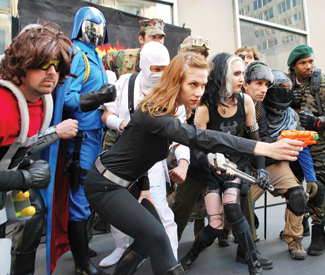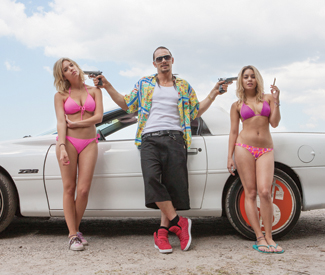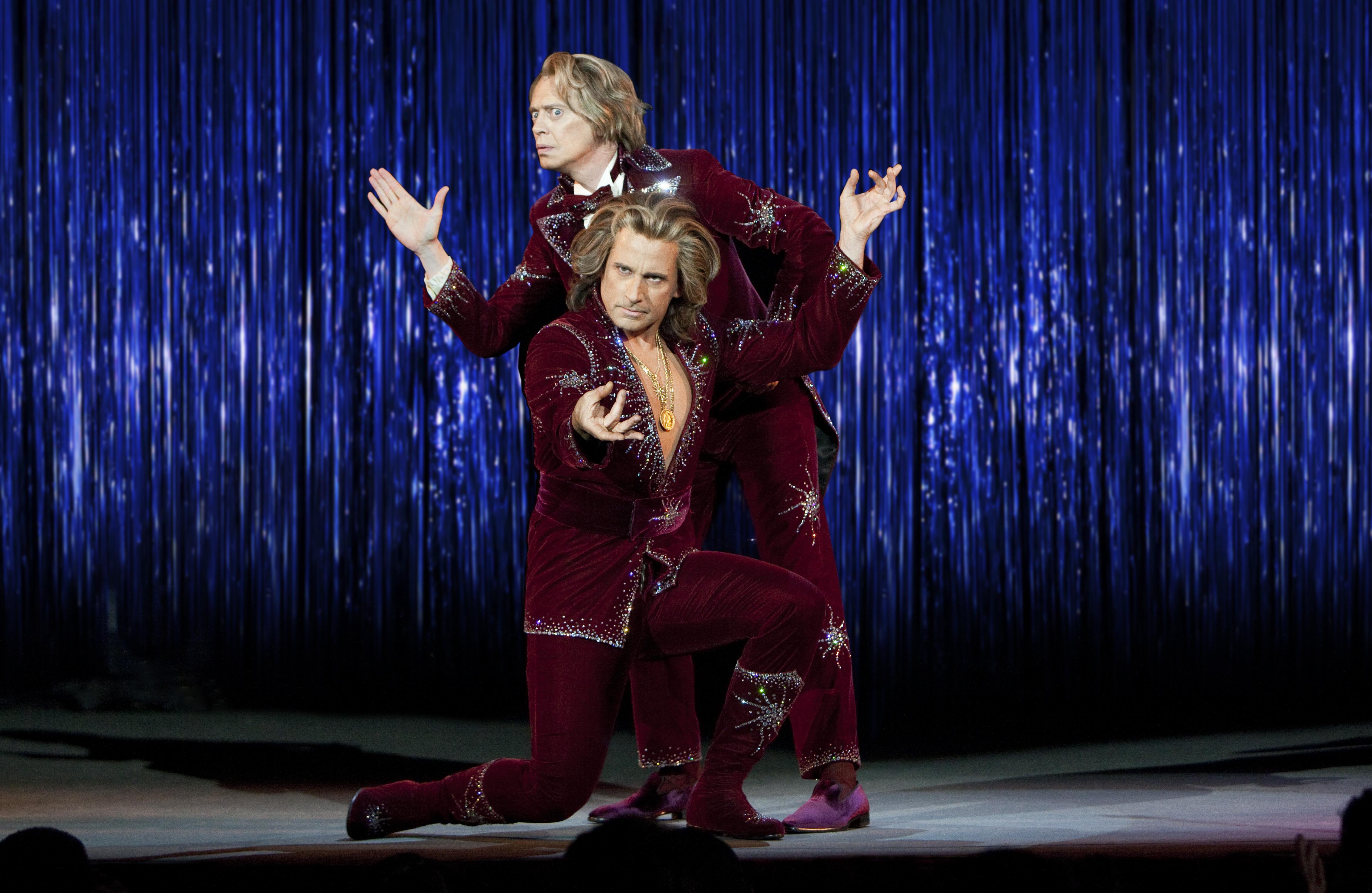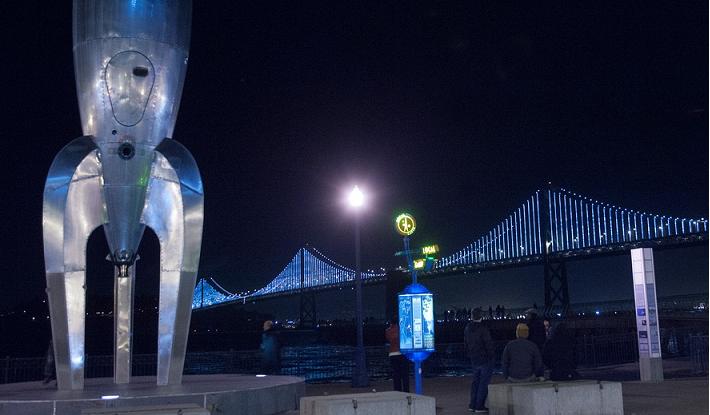Since club life is unpredictable, it’s a good idea to call ahead or check the venue’s website to confirm bookings and hours. Prices are listed when provided to us. Visit www.sfbg.com/venue-guide for venue information. Submit items for the listings at listings@sfbg.com. For further information on how to submit items for the listings, see Picks.
WEDNESDAY 20
ROCK/BLUES/HIP-HOP
Chelsea Light Moving, Grass Widow Great American Music Hall. 8pm, $21.
H is 4 Hector, Elephant Listening Project, Anju’s Pale Blue Eyes, Gordon Welch Red Devil Lounge. 7pm, $14.
Lee Huff vs Greg Zema Johnny Foley’s Dueling Pianos. 9pm, free.
Ivan and Alyosha, Lemolo, Branches Brick and Mortar Music Hall. 9pm, $9-$12.
Koruscant Weekend, Y Axes, Curious Quail Bottom of the Hill. 9pm, $8.
Mindless Things, John Moremens Floatation Device, Tomorrow Men, DJ Sid Presley Elbo Room. 9pm, $5.
Dawn Richard Yoshi’s SF. 8pm, $24.
Terry Savastano Johnny Foley’s. 9pm, free.
Trapped Under Ice, Soul Search, Caged Animal Thee Parkside. 8pm, $10.
Yi, G. Green Hemlock Tavern. 8:30pm, $7.
JAZZ/NEW MUSIC
Dink Dink Dink, Gaucho, Eric Garland’s Jazz Session Amnesia. 7pm, free.
Terry Disley’s Mini-Experience Burritt Room, 417 Stockton, SF; www.mystichotel.com. 6-9pm, free.
Freddie Hughes Royal Cuckoo, 3203 Mission, SF; www.royalcuckoo.com. 7:30-10:30pm, free.
Ricardo Scales Top of the Mark, 999 California, SF; www.topofthemark.com. 6:30pm, $5.
Transcription of Organ Music, Michael Beach, Michael Tapscott Rite Spot Cafe. 9pm.
Craig Ventresco and Meredith Axelrod Cafe Divine, 1600 Stockton, SF; www.cafedivinesf.com.7-9pm, free.
DANCE CLUBS
Booty Call Q-Bar, 456 Castro, SF; www.bootycallwednesdays.com. 9pm. Juanita MORE! and Joshua J host this dance party.
Cash IV Gold Double Dutch, 3192 16th St, SF; www.thedoubledutch.com. 9pm, free.
Coo-Yah! Slate Bar, 2925 16th St, SF; www.slate-sf.com. 10pm, free. With Vinyl Ambassador, DJ Silverback, DJs Green B and Daneekah.
Hardcore Humpday Happy Hour RKRL, 52 Sixth St, SF; (415) 658-5506. 6pm, $3.
Martini Lounge John Colins, 138 Minna, SF; www.johncolins.com. 7pm. With DJ Mark Divita.
Soul Train Revival with Ziek McCarter Boom Boom Room. 8pm, $5.
THURSDAY 21
ROCK/BLUES/HIP-HOP
Aggrolites, Struts, Pinstripes Thee Parkside. 9pm, $17.
Books on Fate, Dandelion War Cafe, In Letter Form, Upstairs Downstairs Cafe Du Nord. 8:30pm, $8.
Gunshy Johnny Foley’s. 9pm, free.
Freddie Jackson Yoshi’s SF. 8pm, $35; 10pm, $25.
Theo Katzman, Joey Dosik, Caleb Hawley Brick and Mortar Music Hall. 9pm, $12-$15.
Landmine Marathon, At Our Heels, Apocryphon, Man Among Wolves DNA Lounge. 9pm, $10.
Lonesome Locomotive, Twin Engine Boom Boom Room. 8pm, $5.
Midnite Independent. 9pm, $27.
Rin Tin Tiger, Emily Bonn and the Vivants, Denim Wedding, Dull Richards Hotel Utah. 9pm, $8.
Lia Rose, Arann Harris and the Farm Band Bottom of the Hill. 9:30pm, $12.
Rudimental, Charlotte Church, Kidnap Kid, popscene DJs Rickshaw Stop. 9pm, $15-$17.
Swells, Torns ACLs, Sunrunners Hemlock Tavern. 8:30pm, $6.
Greg Zema vs Lee Huff Johnny Foley’s Dueling Pianos. 9pm, free.
JAZZ/NEW MUSIC
De Akokan feat. Pavel Urkiza and Ricardo Pons SFJazz Center, 201 Franklin, SF; www.sfjazz.org. 7:30pm, $20-$40. John Santos Presents.
Stompy Jones Top of the Mark, 999 California, SF; www.topofthemark.com. 7:30pm, $10.
Midnight Flyte Rite Spot Cafe. 9pm.
Chris Siebert Royal Cuckoo, 3203 Mission, SF; www.royalcuckoo.com. 7:30-10:30pm, free.
FOLK/WORLD/COUNTRY
“Accordion Babes Revue” El Rio. 9pm, $7.
Craig Ventresco Cafe Divine, 1600 Stockton, SF; www.cafedivinesf.com. 7pm, free.
DANCE CLUBS
Afrolicious Elbo Room. 9:30pm, $8. DJs-hosts Pleasuremaker and Senor Oz spin Afrobeat, Tropicália, electro, samba, and funk.
All 80s Thursday Cat Club. 9pm, $6 (free before 9:30pm). The best of ’80s mainstream and underground.
Base: Pezzner, Gabriel I, Quinn Jerome Vessel, 85 Campton Place, SF; www.vesselsf.com. 10pm, $10.
Ritual Temple. 10pm-3am, $5. Two rooms of dubstep, glitch, and trap music.
Tropicana Madrone Art Bar. 9pm, free. Salsa, cumbia, reggaeton, and more with DJs Don Bustamante, Apocolypto, Sr. Saen, Santero, and Mr. E.
FRIDAY 22
ROCK/BLUES/HIP-HOP
Hoodie Allen Regency Ballroom. 8pm, $24.
Aloha Screwdriver Knockout. 10pm, $7.
Body and Soul Johnny Foley’s. 9pm, free.
Django Django Public Works. 9pm, $20.
Ducktails Chapel, 777 Valencia, SF; www.thechapelsf.com. 9pm, $12-$15.
Finish Ticket, holychild, Ghost and the City, Nikolaus Bartunek Rickshaw Stop. 8pm, $10.
Frail, Night Club, Happy Fangs DNA Lounge. 9pm, $12.
Hotel Eden Milk Bar. 8pm, $10.
Freddie Jackson Yoshi’s SF. 8pm, $35; 10pm, $25.
Jesus and the Rabbis Boom Boom Room. 8pm, $10.
Lianne La Havas, Jamie N Commons Great American Music Hall. 9pm, $21.
Life Stinks, Sex Church, Shark Hemlock Tavern. 9:30pm, $6.
Moonfox, Cusses, Tzigane Society, Cheers Elephant Thee Parkside. 9pm, $8.
Murs, Prof, Fashawn, Black Cloud Slim’s. 9pm, $21.
Pimps of Joytime, Vokab Kompany Independent. 9pm, $22.
Ponies, Kelly McFarling, Gareth Asher Cafe Du Nord. 8:30pm, $12.
Kermit Ruffins and the BBQ Swingers, Billy Iuso and the Restless Natives Brick and Mortar Music Hall. 9pm, $15-$20.
Jeff V., Lee Huff, Greg Zema Johnny Foley’s Dueling Pianos. 9pm, free.
JAZZ/NEW MUSIC
Audium 1616 Bush, SF; www.audium.org. 8:30pm, $20. Theater of sound-sculptured space.
Black Market Jazz Orchestra Top of the Mark, 999 California, SF; www.topofthemark.com. 9pm, $10.
Hammond Organ Soul Jazz, Blues Party Royal Cuckoo, 3203 Mission, SF; www.royalcuckoo.com. 7:30-10:30pm, free.
Michael McIntosh Rite Spot Cafe. 9pm.
Connie Sheu Unitarian Universalist Society of San Francisco Chapel, 1187 Franklin, SF; (415) 776-4580. 7:30pm, $10-$15.
Emy Tseng Red Poppy Art House. 7:30pm.
Papa Vazquez’ “Pirates and Troubadours” SFJazz Center, 201 Franklin, SF; www.sfjazz.org. 7:30pm, $25-$50. John Santos Presents.
FOLK/WORLD/COUNTRY
Baxtalo Drom Amnesia. 9pm, $7-$10. Gypsy punk, belly dance, and more.
La Clave Cigar Bar and Grill, 850 Montgomery, SF; www.cigarbarandgrill.com. 10pm, $10.
DANCE CLUBS
Ghostly International Showcase 1015 Folsom, SF; www.1015folsom.com. 10pm, $20. With secret headliner, Com Truise, Shigeto, Dauwd, Heathered Pearls.
Joe Lookout, 3600 16th St.,SF; www.lookoutsf.com. 9pm. Eight rotating DJs, shirt-off drink specials.
Odyssey Public Works. 9:30pm, $10. With Eli Escobar, Guy Ruben, Robin Simmons.
Old School JAMZ El Rio. 9pm. Fruit Stand DJs spinning old school funk, hip-hop, and R&B.
120 Minutes Elbo Room. 10pm, $10-$15. With Blue Sky Black Death, Deniro Farrar, Child Actor, DJs S4NtA_MU3rTE, Chauncey CC.
Paris to Dakar Little Baobab, 3388 19th St, SF; (415) 643-3558. 10pm, $5. Afro and world music with rotating DJs including Stepwise, Steve, Claude, Santero, and Elembe.
Twitch DNA Lounge. 10pm, $5-$8. With Lebanon Hanover, Jewels of the Nile, DJs Justin, Omar, Rachel Aiello.
Oliver Twizt, SteelE vs Whitock, Tech Minds Vessel, 85 Campton Place, SF; www.vesselsf.com. 10pm, $20-$30.
SATURDAY 23
ROCK/BLUES/HIP-HOP
Nigel Bennett Sub-Mission. 8pm, $5-$7.
Benjamin Brown Shine Lounge, 1337 Mission, SF; www.shinesf.com. 8pm, $8.
Peter Case, Deep Ellum Chapel, 777 Valencia, SF; www.thechapelsf.com. 9pm, $18-$20.
Matt Costa, Carly Ritter Slim’s. 9pm, $16.
Deer Tracks, Magic Wands, RXCCXXNS Thee Parkside. 9pm, $8.
Dengue Fever, Jhameel, DJ Vinroc Rickshaw Stop. 9pm, $25-$35.
Elektrik Sunset, Copper Tones Thee Parkside. 4pm, free.
Equipto, Michael Marshall, Z-Man, Lroneous, Otavo Dubb Elbo Room. 10pm, $15.
Lee Huff, Greg Zema, Jeff V. Johnny Foley’s Dueling Pianos. 9pm, free.
Jinx Jones Riptide. 9pm, free.
Loose Interpretations, Hookslide Amnesia. 6pm.
Andrew McMahon, Barcelona Great American Music Hall. 8pm, $28.50-$30.
Makeunder, Glass Gavel, Freigher El Rio. 9pm.
Milk Music, Gun Outfit, Neon Piss Bottom of the Hill. 9:30pm, $10.
Moira Scar, Lady Bear and Her Dark Dolls, DJ Necromos, Le Perv, Omar Perez Cafe Du Nord. 9:30pm, $7.
Pimps of Joytime, Vokab Kompany Independent. 9pm, $22.
Kermit Ruffins and the BBQ Swingers, Billy Iuso and the Restless Natives Brick and Mortar Music Hall. 9pm, $15-$20.
Specials, Little Hurricane Warfield. 8pm, $37-$47.
Will Sprott, La Luz, Anna Hillburg Hemlock Tavern. 9:30pm, $8.
Steel Panther, Hillbilly Herald Regency Ballroom. 9pm, $25.
Tall Shadows Johnny Foley’s. 9pm, free.
JAZZ/NEW MUSIC
Afro-Cuban Jazz Project with Jimmy Branly Yoshi’s SF. 8pm, $30; 10pm, $25.
Audium 1616 Bush, SF; www.audium.org. 8:30pm, $20. Theater of sound-sculptured space.
Hammond Organ Soul Jazz, Blues Party Royal Cuckoo, 3203 Mission, SF; www.royalcuckoo.com. 7:30-10:30pm, free.
Mario Flores Latin Ensemble Cigar Bar and Grill, 850 Montgomery, SF; www.cigarbarandgrill.com. 10pm, $10.
Ramshackle Romeos Rite Spot Cafe. 9pm.
John Santos’ “Filosofia Caribena” SFJazz Center, 201 Franklin, SF; www.sfjazz.org. 7:30pm, $25-$65.
Ryan Gregory Tallman, Waxy Tombs, Black Spirituals, IN/S Lab, 2948 16th St., SF; www.thelab.org. 9pm, $6-$10.
FOLK/WORLD/COUNTRY
Craig Ventresco and Meredith Axelrod Atlas Cafe, 3049 20th St, SF; www.atlascafe.net. 4-6pm, free.
DANCE CLUBS
Bootie SF: Request Night DNA Lounge. 9pm, $10-$15. Mashups with A Plus D, Dada, Smash-Up Derby.
David Garcia, Justin Milla Vessel, 85 Campton Place, SF; www.vesselsf.com. 10pm, $20-$30.
Opel 11 Year Anniversary Mighty. 10pm, $20. With Felguk, Syd Gris, Melyss, Kimba, and more.
Paris to Dakar Little Baobab, 3388 19th St, SF; (415) 643-3558. 10pm, $5. Afro and world music with rotating DJs.
Re: Edit Underground SF, 424 Haight; www.undergroundsf.com. 10pm. With James Demon, Larry Gonnello Jr., Loryn, and Zenith.
Temptation Cat Club. 9:30pm. $5-$8. Indie, electro, new wave video dance party.
SUNDAY 24
ROCK/BLUES/HIP-HOP
Nigel Bennett Red Devil Lounge. 9pm, $10.
Dirty Hand Family Band, Vans, Angel and the Badman Bottom of the Hill. 7:30pm, $10.
Hans Eberbach Castagnola’s, 286 Jefferson, SF; www.castagnolas.com. 2pm, free.
“Japan Nite 2013” Independent. 8pm, $15. With Pirates Canoe, Jake Stone Garage, JOSY, and more.
Alexz Johnson, Charlene Kay, Jay Stolar, Misty Boyce Brick and Mortar Music Hall. 7pm, $15-$35.
Low Cut Connie Cafe Du Nord. 8pm, $10.
“Markscheider Kunst 20 Year Anniversary” Rickshaw Stop. 7:30pm, $40-$50.
Mutilation Rites, Inter Arma, Embers, Wild Hunt DNA Lounge. 8:30pm, $10.
Nile, Insanity Slim’s. 8pm, $21.
Reptiel, Cassowary, Heroic Trio Hemlock Tavern. 6:30pm, $6.
Terry Savastano Johnny Foley’s. 9pm, free.
JAZZ/NEW MUSIC
Bone Cootes, Barneys Rite Spot Cafe. 9pm.
Citizens Jazz Red Poppy Art House. 7pm, $8-$10.
Gypsy Allstars feat. Gipsy King Family Yoshi’s SF. 7pm, $25; 9pm, $20.
“Switchboard Music Festival” Brava Theater, 2718 24th St., SF; www.switchboardmusic.com. 2-10pm, $20. With Zofo, Subharmonic, Rob Reich Quintet, and more.
Uncommon Time SFJazz Center, 201 Franklin, SF; www.sfjazz.org. 7:30pm, $25-$50. John Santos Presents.
FOLK/WORLD/COUNTRY
Heel Draggers Amnesia. 8pm, $5-$10.
Twang Sunday Thee Parkside. 4pm, free. With Tin Roof Sundae.
DANCE CLUBS
Beats for Brunch Thee Parkside. 11am, free.
Dub Mission Elbo Room. 9pm, $6. With DJ Sep, DJ Theory.
Jock Lookout, 3600 16th St, SF; www.lookoutsf.com. 3pm, $2.
MONDAY 25
ROCK/BLUES/HIP-HOP
Cool Ghouls, Meat Market, Buffalo Tooth, Locomotives Brick and Mortar Music Hall. 8pm, $6.
Damir Johnny Foley’s. 9pm, free.
James Finch Jr., Night Drives, David and Joanna Bottom of the Hill. 8:30pm, $10-$20. SF Bike Coalition benefit in the memory of Rob Koziura.
French Montana, Chinx Drugz Regency Ballroom. 8pm, $27.
Iceage, Merchandise, Wet Hair, DJ Omar Rickshaw Stop. 8pm, $12.
Laura Meyer Osteria, 3277 Sacramento, SF; www.osteriasf.com. 8pm, free.
Today is the Day, Black Tusk, Ken Mode, Fight Amp Elbo Room. 7pm, $15.
JAZZ/NEW MUSIC
Mike Burns Rite Spot Cafe. 9pm.
DANCE CLUBS
Crazy Mondays Beauty Bar, 2299 Mission, SF; www.thebeautybar.com. 10pm, free. Hip-hop and other stuff.
Death Guild DNA Lounge. 9:30pm, $3-$5. Gothic, industrial, and synthpop with Joe Radio, Decay, and Melting Girl.
M.O.M. Madrone Art Bar. 6pm, free. DJs Timoteo Gigante, Gordo Cabeza, and Chris Phlek playing all Motown every Monday.
Soul Cafe John Colins Lounge, 138 Minna, SF; www.johncolins.com. 9pm. R&B, Hip-Hop, Neosoul, reggae, dancehall, and more with DJ Jerry Ross.
Vibes’N’Stuff El Amigo Bar, 3355 Mission, SF; (415) 852-0092. 10pm, free. Conscious jazz and hip-hop with DJs Luce Lucy, Vinnie Esparza, and more.
TUESDAY 26
ROCK/BLUES/HIP-HOP
“#BOTH (Aimee Mann and Ted Leo), John Vanderslice Bottom of the Hill. 9pm, $20.
Caveman, Pure Bathing Culture Independent. 8pm, $15.
Clutch, Orange Goblin, Lionize, Scorpion Child Regency Ballroom. 7:30pm, $24.
Crashdiet, Crucified Barbara, Snakeskyn Whiskey DNA Lounge. 8pm, $13.
Gravy’s Drop, Acid Baby Jesus, Hellshovel, Primitive Hearts Hemlock Tavern. 8pm, $8.
Hopi Astronaut Riptide. 9:30pm, free.
Off With Their Heads, Roll the Tanks, Sydney Ducks, Hear the Sirens Thee Parkside. 8pm, $10.
Papa Bear and the Easy Love, Quiles and Cloud, Mama D and the Dirty Suns Amnesia. 9:30pm, $5-$7.
Schematic, Treehouse Cafe Du Nord. 7:30pm, $10-$12.
Shannon and the Clams, Paint Fumes, Las Ardillas, Lose Vigilantes Knockout. 9:30pm, $8.
Stan Erhart Band Johnny Foley’s. 9pm, free.
Veronica Falls, Brilliant Colors, Golden Grrrls Rickshaw Stop. 8pm, $12-$14.
JAZZ/NEW MUSIC
Terry Disley’s Mini-Experience Burritt Room, 417 Stockton, SF; www.mystichotel.com. 6-9pm, free.
FOLK/WORLD/COUNTRY
Boca do Rio Yoshi’s SF. 8pm.
Toshio Hirano Rite Spot Cafe. 9pm.
DANCE CLUBS
Scraps! DJ Night Chapel, 777 Valencia, SF; www.thechapelsf.com. 8:30pm, free.
Stylus John Colins Lounge, 138 Minna, SF; www.johncolins.com. 9pm. Hip-hop, dancehall, and Bay slaps with DJ Left Lane.
Takin’ Back Tuesdays Double Dutch, 3192 16th St,SF; www.thedoubledutch.com. 10pm. Hip-hop from the 1990s.












